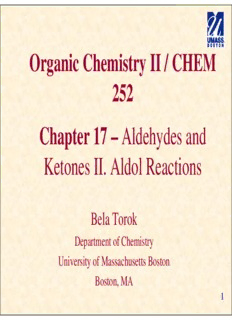
Organic Chemistry II / CHEM 252 Chapter 17 – Aldehydes and PDF
Preview Organic Chemistry II / CHEM 252 Chapter 17 – Aldehydes and
Organic Chemistry II / CHEM 252 Chapter 17 – Aldehydes and Ketones II. Aldol Reactions Bela Torok Department of Chemistry University of Massachusetts Boston Boston, MA 1 Acidity of Carbonyl Compounds • The Acidity of the α Hydrogens of Carbonyl Compounds: Enolate Anions • Hydrogens on carbons α to carbonyls are unusually acidic – The resulting anion is stabilized by resonance to the carbonyl 2 Acidity of Carbonyl Compounds – The enolate anion can be protonated at the carbon or the oxygen • The resultant enol and keto forms of the carbonyl are formed reversibly and are interconvertible 3 Keto-Enol Tautomerism • Keto and Enol Tautomers • Enol-keto tautomers are constitutional isomers that are easily interconverted by a trace of acid or base – Most aldehydes and ketones exist primarily in the keto form because of the greater strength of the carbon-oxygen double bond relative to the carbon-carbon double bond 4 Keto-Enol Tautomerism − β-Dicarbonyl compounds exist primarily in the enol form – The enol is more stable because it has a conjugated π system and because of stabilization of the enol through hydrogen bonding 5 Reactions via Enols/Enolate Ions – Racemization • An optically active aldehyde or ketone with a stereocenter at the α-carbon can racemize in the presence of catalytic acid or base – The intermediate enol or enolate has no stereocenter at the α position 6 Reactions via Enols/Enolate Ions • The mechanisms of base and acid catalysed racemization are shown below 7 Reactions via Enols/Enolate Ions – Halogenation of Ketones • Ketones can be halogenated at the α position in the presence of acid or base and X 2 – Base-promoted halogenation occurs via an enolate 8 Reactions via Enols/Enolate Ions – Acid-catalyzed halogenation proceeds via the enol 9 Reactions via Enols/Enolate Ions – Haloform Reaction • Reaction of methyl ketones with X in the presence of base results in 2 multiple halogenation at the methyl carbon 10
Description: